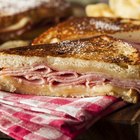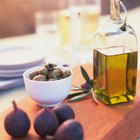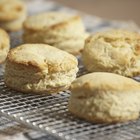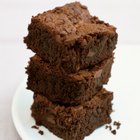
Making your own butter definitely takes more time than picking up a package at the store, even though contemporary shortcuts for butter churning make this a faster do-it-yourself project than in the old days. Whether the results are superior to store-bought comes down to a matter of taste. For some, the differences may be too subtle to appreciate.
Costs of Home Churning
Expense is a consideration when deciding whether to churn your own butter. Homemade butter costs more than twice as much as store-bought, according to "Bon Appetit" magazine. Its comparison test pitted homemade butter made with regular heavy cream against a store-bought "natural butter." The homemade version cost $4.79 per cup vs. $2 per cup for the store-bought butter. The expense of making homemade butter from organic cream or cream labeled as being from grass-fed cows is even higher than regular commercially produced cream and would result in an even more expensive homemade product.
Taste Tests
A flavor comparison of homemade vs. store-bought butter comes down to personal preferences. Your palate may find that homemade butter has a better flavor, yet many people won't be able to tell the difference. Some people can tell the difference between dairy from cows of different breeds, and other people can't. One advantage to making your own butter is that you can control the salt content for flavor and amounts. For example, you might make a lower-salt butter, with a flavor between store-bought unsalted and salted butter.
Reasons to Make Your Own
Choosing the ingredients to put in your butter gives you the option to go organic. This allows you to avoid pesticides and hormones or colorings that may be present in commercial butter. Homemade butter made from the cream of grass-fed cows provides more essential fatty acids -- healthy fats -- and also more carotene, vitamin A and vitamin E, Mother Earth News reports. You may even have access to milk from a local dairy, which can give you the peace of mind of knowing where the cows graze. Homemade butter, because of its less uniform texture and higher fat concentration, may result in superior pastry items. Homemade butter from pastured cows also spreads better than butter from grain-fed cows, according to Mother Earth news.
The Downside
Homemade butter is higher in butterfat, an advantage for pastry lovers but not for those watching their calorie intake. Home-churned butter also has a shorter life in the refrigerator, only two to three weeks, and carries a risk of becoming rancid within a week if all the buttermilk isn't removed, "Bon Appetit" reports.
Related Articles

Adding Cold Water to Whipped Butter

Monte Cristo Sandwich Calories

How to Store Butter

Vegan Alternatives to Lanolin in ...

Can I Substitute Coconut Milk for ...

What Is the Benefit of Olive Butter for ...

Substitute for 1 Square of Baking ...

Is Cashew Butter Healthy?
How Long Can You Keep Butter ...

Why Can't You Use Ultra Pasteurized ...
The Difference Between ...

What Is the Highest Quality Butter for ...
How Long Can Unsalted Butter Go ...

Can I Sub Condensed Milk for Cream in ...

Heavy Cream vs. Milk in Baking

Avocado Butter Hair Treatment

Butter Substitute for Baking Scones

Substitutes for Butter When Baking ...

Why Does Cream Turn Into Butter?

Substitution for Oil in Baking Brownies
References
Resources
Writer Bio
Gryphon Adams began publishing in 1985. He contributed to the "San Francisco Chronicle" and "Dark Voices." Adams writes about a variety of topics, including teaching, floral design, landscaping and home furnishings. Adams is a certified health educator and a massage practitioner. He received his Master of Fine Arts at San Francisco State University.
Photo Credits
Comstock Images/Comstock/Getty Images